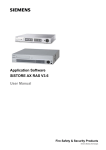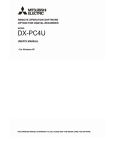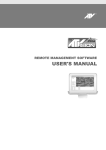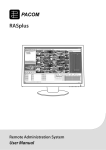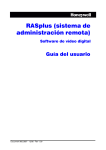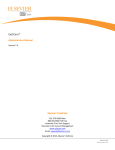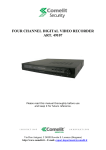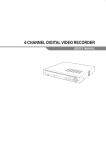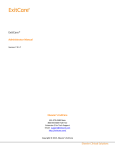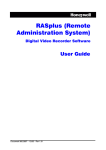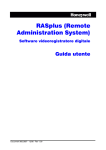Download RASPlus User Manual
Transcript
Remote Administration System Plus (RASplus) Table of Contents Chapter 1 ─ Overview ............................................................................. 1 1.1 In This Manual .............................................................................. 1 1.2 RASplus Features......................................................................... 1 1.3 Product Information ...................................................................... 1 Chapter 2 ─ Installation ........................................................................... 3 Chapter 3 ─ Configuration ....................................................................... 9 3.1 3.2 3.3 3.4 Screen .......................................................................................... 9 Panel........................................................................................... 10 Menu........................................................................................... 16 Toolbar........................................................................................ 30 Chapter 4 ─ Operation........................................................................... 33 4.1 4.2 4.3 4.4 Live Monitoring ........................................................................... 33 Playback and Search.................................................................. 36 Panic Recording ......................................................................... 43 Status View................................................................................. 43 Appendix A ─ Reviewing Video Clips .................................................... 47 Appendix B ─ DVR Name Service (DVRNS)......................................... 51 Appendix C ─ Map Editor ...................................................................... 52 i User’s Manual ii Remote Administration System Plus (RASplus) Chapter 1 ─ Overview 1.1 In This Manual This manual describes installation and operation of RASplus (Remote Administration System Plus) software, which is designed to be used with remote digital video recorders (DVRs) 1.2 RASplus Features RASplus program is an integrated software program that controls system management, video monitoring, video recording and image playback of multiple remote DVRs. RASplus offers the following features: y y y y y y y y y Checks and reports status of remote DVRs Notification of events detected at remote sites Remote monitoring of live camera images Panic recording of monitored images Time-lapse and event search of recorded images Remote software upgrades and system programming View system and event log information of remote DVRs Remote monitoring of multiple remote sites using 3D maps Connect up to 16 remote sites at a time 1.3 Product Information Package Components y y User’s Manual (this document) Installation CD System Requirements y y y y Operating System: Microsoft Windows XP or later CPU: Intel Pentium IV (Celeron) 2.4GHz or faster RAM: 512MB or higher VGA: AGP, Video RAM 8MB or higher (1024x768, 24bpp or higher) 1 User’s Manual 2 Remote Administration System Plus (RASplus) Chapter 2 ─ Installation CAUTION: If an older version of RASplus software is installed in your computer, you should uninstall the older version first. NOTE: In the Start menu in Windows, go to Control Panel. Double click the Power Options to evoke the Management Properties dialog box. Under the Power Schemes tab, set both Turn off monitor and Turn off hard disks to Never. 1. Insert the installation CD. 2. Run the Setup.exe file. 3. When the following dialog box appears, click Accept. NOTE: Installing .NET Framework is required for RASplus to operate properly. This installation step will be skipped if .NET Framework is already installed on your computer. 4. When the following dialog box appears, click Install. NOTE: Installing the Visual C++ Runtime Libraries is required for RASplus to operate properly. This installation step will be skipped if the Visual C++ Runtime Libraries are already installed on your computer. 3 User’s Manual 5. When the following dialog box appears, click Next. 6. Designate the folder path to install RASplus and select the user(s) who can use RASplus. Then click Next. 7. Select whether or not to run RASplus automatically when logging onto Windows, and then click Next. 4 Remote Administration System Plus (RASplus) 8. Click Next. 9. Set the language option by selecting either Select language when starting RASplus or Always start RASplus using the language below. If you select Always start RASplus using the language below, select the desired startup language from the list of available languages and then click OK. NOTE: To properly display the selected language, your PC’s operating system should be set to support the selected language. NOTE: In order to change RASplus’ language after selecting the Always start RASplus using the language below option, the RASplus software should be reinstalled. 5 User’s Manual 10. When the following dialog box appears after finishing the RASplus installation, select Install MSXML application and click Finish. Installing the MSXML is required for RASplus to initiate. 11. Click Next. 12. Select I accept the terms in the License Agreement, and click Next. 6 Remote Administration System Plus (RASplus) 13. Enter User Name and Organization, and click Next. 14. Select Install Now. 15. Click Finish to complete the MSXML installation. 7 User’s Manual 8 Remote Administration System Plus (RASplus) Chapter 3 ─ Configuration After installing the RASplus software, you will find the RASplus shortcut icon on the desktop. Run the RASplus program by double clicking the icon. The RASplus program consists of the screen, 12 docking panels, menu and toolbar. 3.1 Screen The Screen displays images from selected cameras in the live monitoring or playback modes. RASplus provides various multi-screen layouts; single-screen, quad, 1+7, 3x3, 4x4, 5x5, 1+32, 6x6, 7x7, 8x8 and full-screen. 9 User’s Manual NOTE: There might be a problem with screen display or screen update due to low image transmission speed when using the Microsoft Windows Vista operating system. In this situation, it is recommended that you disable the Auto Tuning capability of your computer. Run the Command Prompt with elevated administrator permissions (Go to the Start Menu Æ Accessories Æ Command Prompt Æ Click the right mouse button and select the Run as administrator option). Then enter “netsh int tcp set global autotuninglevel=disable” and click the OK button. Restart your computer to apply the changes. If you want to enable the Auto Tuning capability again, enter “netsh int tcp set global autotuninglevel=normal” after running the Command Prompt with elevated administrator permissions. Restart your computer to apply the changes. 3.2 Panel RASplus has many powerful tools that can be used to streamline your work. Most of the tools are located on 12 docking panels that can be placed on the screen where they are most convenient. You can keep your screen free of clutter by displaying only the panels you use most frequently. Clicking the icon in the upper right corner of a panel enables the auto-hide feature. Tabs for autohidden panels are displayed on the side of the screen. Scrolling over an auto-hidden panel tab will cause the panel to "fly" out. You can cause the panel to lock back into its original display position by clicking the icon. Clicking the icon hides the panel without a tab. Hidden panels can be displayed by selecting them from the drop-down menus. Panels can be resized, moved and combined with other panels creating a workspace that fits your needs. To resize a panel, scroll the cursor over the edge of the panel until the cursor changes to or . Then click the left mouse button and drag the panel border to enlarge or reduce its size. To move a panel to a different position on the screen, scroll the cursor over the title bar of a panel that has not been auto-hidden until it changes to . Once you click and drag, position arrows will display on the screen. The four position arrows along the outer edges allow you to place the panel along the given edge independent of the other panels. When you drag the panel over a position arrow, a transparent blue box will display showing the new panel position. If you are satisfied with the position, release the left mouse button and the panel will move to its new position. You can also move a panel so that it is associated with another panel. To do this, drag the panel over the panel you want it associated with, and the icon with four position arrows will center over that panel. Scrolling the cursor over the icon arrows will cause a transparent blue box to display where the panel will be located. If you are satisfied with the position, release the left mouse button and the panel moves to its new position. It is possible to combine panels so that they take up less space on the screen. Combined panels have a row of tabs across the bottom. Clicking a tab brings that panel to the foreground. To combine panels, move the cursor to the title bar of the panel you want to move. Click and drag the panel onto the panel you want to combine it with. If the panels can be combined, the four-position arrow icon will have a tab symbol in the center. Drag the cursor over the tab symbol , and a new tab appears on the panel. Release the mouse button and the panels will now be combined. The layout possibilities are virtually unlimited. With a little experimentation you will be able to lay out the screen so that it best meets your workflow. 10 Remote Administration System Plus (RASplus) Remote Sites Panel The Remote Sites Panel displays a list of remote sites registered during RASplus System setup and a list of installed cameras at the remote sites. Entering the site name in the query box and clicking the icon allows you to find the remote site easily in the Remote Sites list. Clicking the icon allows you to register the remote site, clicking the icon removes the selected remote site from the list, and clicking the icon allows you to edit the site information of the selected remote site from the list. To connect to a remote site, select the site or camera you want to connect to from the list and then drag and drop it in the desired position on the screen or the Status View panel. The screen displays images from selected cameras, and the Status View panel displays the system status information of the connected remote site. Connecting to the Status View panel can also be done by selecting Connect Status View from the popup menu displayed by clicking the right mouse button after selecting the site from the list. This popup menu initiates the remote menu including Remote Setup, Remote System Log, and Remote Event Log. Refer to 3.3 Menu – Remote Menu for more details. Favorite Sites Panel The Favorite Sites panel displays the list of Favorite sites registered during RASplus System setup. Selecting the Favorite site you want to connect to from the list and then dragging and dropping it in the desired position on the screen connects all remote sites registered in the Favorite site automatically. Search View Panel The Search View panel allows time-lapse or event searching of recoded data on the remote DVR. NOTE: Refer to 4.2 Playback and Search for more details. 11 User’s Manual Map Panel The Map panel allows efficient monitoring of the remote sites by displaying a three-dimensional map of the selectable site. Click the right mouse button on the map panel to select the map image file (.rmp) you want to monitor from the list. The selected map image displays in the Map panel and the sites registered on the map image file will be connected. When the selected map is linked with sub-maps, clicking the linked image moves to the sub-map. To connect to the remote site, select the device you want to connect to from the Map panel and then drag and drop it in the desired position on the screen or the Status View panel. Also, placing the mouse cursor on the device on the map displays the device status. When the device detects any event or the device is not working properly, the following status icons appear (maximum of 4). Unplugged Motion Event off Alarm In Irregular Alarm Out Video Loss NOTE: The status of devices is displayed as Irregular based on to the settings in System Check and as Video Loss, Motion, Alarm In and/or Alarm Out according to the event detection settings on the remote DVR. Clicking the right mouse button on the Map panel causes a text menu screen to display. Selecting Watch Event View from the menu displays the event information of the connected remote sites. Selecting Close disconnects the current connection on the Map panel. The Map panel pops up another screen when alarm-in, motion or video loss events are detected or when you click the device icon according to the Map Editor settings. Refer to Appendix C- Map Editor – Device Setting section for more details about the popup function. Change the popup screen location by clicking the left mouse button on the screen and dragging it to where you want it located. Clicking the right mouse button on the popup screen displays the following popup menu. y x0.25 to x2: Sets the desired size of the Map popup screen. y Draw Motion Block: Displays the area that detects motions on the screen. (Network Video Server connection only) y Full Screen: Enters the full-screen mode of the Map popup screen. y Transparency…: Adjusts the transparency of the popup screen. y PTZ Set…: Controls pan, tilt and zoom of the selected PTZ camera. 12 Remote Administration System Plus (RASplus) y Disable Dwell Time: Disables the dwell time out for the map popup screen that displays when events are detected. y Original Ratio: Displays the Map popup screen by matching its original aspect ratio. y Anti-Aliasing Screen: Enhances image display quality on the popup screen by smoothing stair stepping (aliasing) effects in the enlarged image. y User Set…: Sets the mode of the current popup screens displayed on the monitor. For example, the monitor displays the current popup screen with enough frames for 16 cameras when you select 4x4. NOTE: Refer to Appendix C – Map Editor for details on editing maps. Color, PTZ and Alarm Out Control Panels Three panels allow color control, PTZ control and alarm out control while live monitoring a remote site. NOTE: Refer to 4.1 Live Monitoring for more details. Image Processing Panel The Image Processing panel allows enhancing played back images. NOTE: Refer to 4.2 Playback and Search for more details. 13 User’s Manual Emergency Event View Panel The Emergency Event View panel displays a list of events (preset for notification at the remote site) that were called from individual remote sites (LAN connection only). Selecting an event from the list and then dragging and dropping it in the desired position on the Watch or Search screen connects to the remote site, and a checkmark is placed in the box at the left. Selecting an event or site from the list and then clicking the right mouse button causes a tooltip to appear, which contains the emergency event instruction from the remote site. Watch Event View Panel The Watch Event View panel displays events detected at individual remote sites while RASplus is in the live monitoring mode. The description of event icons is as follows: Normal Event Motion Detection Video Blind Recorder Bad Disk Full Panic Recording Off 14 Alarm In On Object Detection Text In Disk S.M.A.R.T. Disk Temperature Alarm In Off Video Loss Alarm In Bad Disk Bad Panic Recording On Remote Administration System Plus (RASplus) Report View Panel The Report View panel displays the system status information of remote sites. RASplus checks the remote site and reports system status. Report Setup must be configured during RASplus System setup for this feature to function. Refer to 3.3 Menu – System Menu for more details. NOTE: Some report options may not be supported, depending on the specifications of the remote DVR. Status View Panel The Status View panel displays the event, alarm out, system check, object detection, video blind detection and recording status information of the connected remote site in real-time. To connect to the remote site, select the site or camera you want to connect to from the Remote Site or Map panel and then drag and drop it in the Status View panel. NOTE: Refer to 4.4 Status View for more details. 15 User’s Manual 3.3 Menu System Menu X Setup The Setup screen allows setting up the system operation and remote site configuration. 16 Remote Administration System Plus (RASplus) System 1: Set up the date/time format for RASplus, display option, and panic recording function. y y Date/Time Format: Set the date/time format. Display Option: Set up the screen display, drag & drop popup option, display acceleration and OSD. – Screen Option: Select Watch Screen to use the screen for live monitoring only, Search Screen to use the screen for search only, or Watch and Search Screen to use the screen for both live monitoring and searching. Selecting Hide the Message Box hides the message box that displays the status information about RASplus and remote site connections. – Drag & Drop Popup Option: Select which mouse button will be used when displaying popup menu screens from Use Left Mouse Button, Use Right Mouse Button or both (Watch and Search Screen mode only). – Drawing Mode Setup…: Select the draw mode level. y Normal Drawing: Depends on your PC’s CPU performance and displays images in low speed (DIB Draw Mode). y Fast Drawing (Default): Displays image in normal speed (Direct Draw Mode). y Fast Drawing (YUV420/RGB32): Depends on your PC’s video card performance and displays images in high speed (Direct Draw Mode (YUV420/RGB32)). y Overlay (YUV420/RGB32/RGB565): Displays image in high speed (Direct Draw Overlay Mode (YUV420/RGB32/RGB565)). NOTE: If the image cannot be displayed properly because of your PC’s specifications, lower the drawing mode level. NOTE: While in the Fast Drawing mode, the drawing speed might decrease when the RASplus screen is not located on the primary monitor. NOTE: Overlay drawing mode may not be supported, depending on the type of video card installed in your PC. Video cards with an ATI chipset are recommended. NOTE: When using dual monitors, selecting Overlay drawing will display the image only on the primary monitor. – OSD Setup…: Select options (Title, Time Info, Date Info, Text-In and Overlay Text-In Data) to display on the screen. y Recording Setup: Set up the Use (On or Off) of the panic recording function and overwriting option of the recording folder (On or Off). When using the panic recording function and overwriting option, RASplus continues recording when the hard disk drive is full by overwriting the oldest video. Designate a recording folder path and set the recording folder size from 640MB to 2048MB. Capacity shows the remaining space of the recording folder. NOTE: The recording folder size cannot be changed once it has been set. Designate another recording folder path if you want to expand the recording space. – Recording Mode Setup…: Set up the panic recording mode. 17 User’s Manual y Visible Watch Camera: Records camera channels currently displayed on the Watch screen. y User Assignment Setup: Record camera channels assigned by the user on the Watch screen. y Camera Range Setup: Records camera channels within preset channel range. Select the boxes beside Camera and adjust camera range up to 16 channels NOTE: Panic recoding will NOT be made for the cameras currently not displayed on the Watch screen even though they are set up to be recorded. NOTE: When selecting the User Assignment Setup mode, the user can assign camera channels to record manually on the Watch screen. Select a camera on the Watch screen and click the right mouse button then select Select Record Camera in the text menu screen. The gray icon displays on the selected camera screen. System 2: Set up the modem connection information for remote access, system password, network option, report function and DVRNS server. y y y Dial-up Network: Select Use modem if you want to use a modem for remote access. Security Options: Designate whether password confirmation is required Before setup, Before startup, or Before shutdown of RASplus. Click the Change button to change the password. Network Option: Set up the IP port number (from 8000 to 12000) that is used for network connection when receiving a callback message from a remote site, and the upgrade port number that is used for upgrading the PC-based DVR. 18 Remote Administration System Plus (RASplus) NOTE: The IP port and upgrade port numbers you enter should match the values set during the network setup of the remote DVR. – Event Setup…: Enter the number of emergency events displayed in the Emergency Event panel. Set up RASplus to sound when events are detected by selecting events from the list and designating the sound file (.wave) path. You can set up a different sound for each type of event. y y Report Setup: Set up the Use (On or Off) and check intervals (from 1 to 24 hours) of the report function. When using the report function, RASplus checks on the remote site based on the user-defined interval and reports system status. DVR Name Service: Set up the IP address and port number (from 10000 to 12000) of the DVRNS (DVR Name Service) server. The IP address and port number you enter should match the values set during the DVRNS setup of the remote DVR you want to connect to. NOTE: The DVRNS server cannot be configured when using modem connections. Refer to Appendix B for more details on DVR Name Service. 19 User’s Manual Remote Site: Configures the connection list for remote access. y Add: Click the Add button and enter the information about the remote site you want to add. – Reference Group: The site should be assigned to a Reference Group for effective management of multiple remote sites. Click the Add button to create a new reference group. – Remote Site Setup: Select PC Based DVR when registering a DVR at the remote site that is PC based. Enter a site name and the IP address of the remote site (modem telephone number for dial-up connections), acquired from your network administrator. Click the Port… button to set up the IP port number of each program. The IP port number should match the value set during the network setup of the remote DVR. If the remote DVR version does not allow you to set the IP port numbers, use the following values: “8200” for Admin, “8016” for Watch, “10019” for Search, and “8116” (“8115” for a PC-based DVR) for Audio. Select the number of cameras at the remote site. For example, selecting “8” from the list when registering a 16-channel DVR displays video of the first 8 channels on the screen. NOTE: When using DVRNS server, place a checkmark in the Use DVRNS box, and enter the site name and DVR name of the remote site in the IP address box. The DVR name you enter should match the DVR name set during the DVRNS setup of the remote DVR. – Login Setup: Enter the user ID and password of the remote site to be accessed. If you have entered a user ID and a password, the site will be connected automatically without a dialog box requesting a password. Select No Password for remote systems that do not require a password (e.g., guest login). NOTE: Up to 32 characters may be used for the site names, telephone numbers and user IDs, and up to 10 characters may be used for passwords. – Emergency Event Instruction: Enter the message to display when emergency events are called in from the remote site. The Emergency Event Instruction can be checked by clicking the right mouse button after selecting the event or the site from the list in the Emergency Event panel. y y y y Change: Select the group or site you want to change and click the Change button, or double click the group or the site to change. Then, edit the site information. Remove: Select the group or site you want to remove and click the Remove button. List All: Displays all registered remote sites. Find: Enter the group name or site name to search for and click the Find button to display the matching groups or sites in the list. 20 Remote Administration System Plus (RASplus) Favorite Site: The Favorite Site is a user-defined connection list that combines more than one remote site, so multiple sites can be monitored at the same time with a single connection. Add a new Favorite Site and define it by dragging and dropping sites and/or cameras to the Favorites map. Up to 64 cameras can be monitored at a time when each camera is assigned to its own position on the Favorites map. y y y y Favorites – Site Name: Select a registered Favorite site from the drop-down list. – ADD: Adds a new Favorite site. – Change: Select the Favorite site to change from the Site Name list and click the Change button. Then change the site name. – Remove: Select the Favorite site to remove from the Site Name list and click the Remove button. Connect Favorite Site at startup: Select whether or not your favorite site is automatically connected when RASplus starts. Remove Selected Camera: Removes selected cameras from the Favorites map. Cameras can also be removed by clicking the right mouse button after selecting the camera. Remove All Cameras: Removes all cameras from the Favorites map. NOTE: Cameras can be selected by clicking the left mouse button on the camera in the Favorites map. Selected cameras will be outlined in red. Clicking the left mouse button on the camera while holding the Ctrl key toggles camera selection On and Off. Multiple cameras can be selected by clicking the left mouse button while holding the Shift key. 21 User’s Manual NOTE: “[W]” (Watch Screen) and “[S]” (Search Screen) displayed to the left of the camera number indicates the display option of each camera. The display option can be selected when registering a Favorite site. Selecting the remote site from the Group List and dragging and dropping it to the Favorites map using the right or left mouse buttons (This is user-defined and must be set during System setup) displays the text menu screen. Select the desired displays option between Watch Screen and Search screen. If you do not select the display option, Watch Screen display will be assigned to all cameras of the registered Favorite site by default. button on the toolbar will save the current screen layout of the Watch NOTE: Clicking the screen or Search screen directly to the Favorite site. NOTE: The Favorite Site list does not work with modem connections. Sequence Site: Configure the sequence site. RASplus connects to the registered sites sequentially allowing connection to more than one remote site. y y y y y Sequence dwell time: Adjust sequence intervals (from 5 seconds to 1 hour) for each connection. Add: Select the site to add from the Group List and click the Add button. Add All: Adds all sites in the Group List to the Auto Sequencing list. Remove: Select the site to remove from the Auto Sequencing list and click the Remove button. Remove All: Removes all sites in the Auto Sequencing list. NOTE: The Auto Sequencing list is not valid with modem connections. 22 Remote Administration System Plus (RASplus) X Batch Job Setup Multiple remote sites can be upgraded or set up using the Batch Job Setup screen. Upgrade: Sets up the remote upgrade job for remote sites. First, select the remote sites to upgrade from the Group List, and add them to the Upgrade Sites list by clicking the Add button. Then, click the Upgrade Now button to initiate the remote upgrade job for registered Upgrade Sites. y y y y y Add: Select the site to add from the Group List and click the Add button. Add All: Adds all sites in the Group List to the Upgrade Sites list. Remove: Select the site to remove from the Upgrade Sites list and click the Remove button. Remove All: Removes all sites in the Upgrade Sites list. Upgrade Now: Upgrades the software on the Upgrade Sites. NOTE: When upgrading a PC-based DVR, select PC Based DVR and then select the desired upgrade folder. 23 User’s Manual Setup: Sets up the remote setup job for remote sites. First, select the remote sites to set up from the Group List, and add them to the Setup Sites list by clicking the Add button. Then, click the Setup Now button to initiate the remote setup job for Setup Sites. y y y Add: Select the site to add from the Group List and click the Add button. Remove All: Removes all the sites in the Setup Sites list. Setup Now: Performs the setup on the Setup Sites. NOTE: Batch job setup of remote sites is NOT supported for the PC-based DVRs. X Disconnect Disconnects all current connections. Disconnection can also be performed by clicking the the toolbar. button on X Log Log displays the system, batch job, report and check emergency log information of RASplus, and the log information of emergency events called in from remote sites. It displays up to 5,000 log entries. 24 Remote Administration System Plus (RASplus) File y y y y Log File Open: Opens the saved log file. Save As…: Saves the log information as a text file. Print: Prints the log information. Exit: Closes the Log dialog box. View y y Show All Logs: Displays all log entries. Show Filtering Log: Displays log entries within the parameters set by the filter options. Enter the Site name, select the filter options, and set the search starting date/time and ending date/time. Leaving the Site field blank displays log entries of all registered sites. 25 User’s Manual y y y New Log First: Displays the newest log first. Old Log First: Displays the oldest log first. Column Add or Remove: Adds or removes columns in the Log dialog box. X Exit Disconnects all current connections and exits RASplus program. View Menu Displays or closes the toolbar and panels. Remote Menu NOTE: The Remote menu can also be activated by clicking the right mouse button after selecting the remote site on the Remote Sites panel. X Remote Setup Remote Setup can be used to change the setup of a remote DVR. Select the remote site on the Remote Sites panel, initiate the Remote Setup menu, and the setup screen displays. 26 Remote Administration System Plus (RASplus) NOTE: Refer to the user manual for the remote DVR for more details on system setup. X Remote System Log/Remote Event Log These selections display the system log and event log information of a remote DVR. Set the time range of interest and click the Find button. The log entries within the time range displays in the list. 100 results can be displayed in a single page. Click the Move buttons to display additional results. y y y y y y y From: Adjust the search starting date and time. When First is selected, it will search from the first logged item. To: Adjust the search ending date and time. When Last is selected, it will search to the last log. Find: Displays remote log entries within the selected period. Print...: Prints the log information. Save...: Saves the log information as a text or cvs file (UTF-8 encoded). Move Buttons: Moves to the first page ( ), previous page ( ), next page ( ) or last page ( ). You can go directly to a log page by clicking the page number button. Close: Closes the Log dialog box. Favorite Menu NOTE: The Favorite menu can also be accessed using the toolbar controls. Saves the current screen layout directly to the Favorite site. 27 User’s Manual Sequence Menu NOTE: The Sequence menu can also be accessed using the toolbar controls. Starts or ends auto sequencing. Record Menu NOTE: The Record menu can also be accessed using the toolbar controls. Starts or ends panic recording. Selecting Record Play initiates the RecordPlayer program and plays recorded video. Refer to 4.3 Panic Recording for more details. Image Menu NOTE: The Image menu can also be accessed using the toolbar controls. y y Save: Saves the current image as a bitmap or JPEG file. Print: Prints the current image. NOTE: Refer to 4.1 Live Monitoring and 4.2 Playback and Search for more details. Layout Menu NOTE: The Layout menu can also be accessed using the toolbar controls. 28 Remote Administration System Plus (RASplus) X Screen Layout Select the desired screen layout using the layout toolbar. When changing the screen layout, the selected camera on the current screen will be located in the first cell of the new layout. When in one of the multi-view formats, selecting Previous Layout or Next Layout will move to the previous or next page. In other words, when viewing Cameras 1 to 4 in the quad format, selecting Previous Layout will display Cameras 61 to 64 and selecting Next Layout will display Cameras 5 to 8. Selecting Full Screen enters the full-screen mode, and returns to the previous screen mode by pressing the Esc key on the keyboard or selecting FullScreen Close (x) from the popup menu displayed by clicking the right mouse button. X Frame Layout – Layout Load: Select the desired frame layout and click the Load button to apply the selected frame layout to RASplus. y Default Layout: Displays all the panels on the screen. y Watch Layout: Displays only the panels that are used most frequently in the Watch screen mode. y Search Layout: Displays only the panels that are used most frequently in the Search screen mode. y Admin Layout: Displays only the panels that are used most frequently in the Admin screen mode. y User Defined Layout: Displays the user-defined layout. – Layout Setup: The user can configure the frame layout by displaying panels on the screen where they are most convenient. Set up the user-defined frame layout. 29 User’s Manual y Always Load Layout at RASplus Startup: Select whether or not the selected frame layout loads automatically when RASplus starts. y Save: Enter a layout name and click the Save button to save the current frame layout as a new user-defined layout. y Rename: Select the layout to change from the Layout List and click the Rename button. Then change the layout name. y Delete: Select the layout to delete from the Layout List and click the Delete button. NOTE: Up to 10 user-defined layouts can be saved. Help Menu Displays RASplus version information. 3.4 Toolbar The Toolbar allows convenient access to desired functions. The controls on the toolbar perform functions as described below: Disconnect System Log Report Log Auto Sequence Panic Recording 30 RASplus Setup Emergency Event Log Check Emergency Log Save Play Batch Job Setup Batch Job Log Save Favorite Sites Print Remote Administration System Plus (RASplus) Select the desired screen layout using the layout toolbar. When changing the screen layout, the selected camera on the current screen will be located in the first cell of the new layout. When in one of the or button will move to the previous or next page. multi-view formats, clicking the Clicking (Layout Load) will apply the selected frame layout to RASplus, and clicking Setup) allows you to set up the user-defined frame layout. (Layout 31 User’s Manual 32 Remote Administration System Plus (RASplus) Chapter 4 ─ Operation 4.1 Live Monitoring RASplus provides remote monitoring functions for viewing video images in real time from either a single site or multiple sites. In addition, when events are detected at a remote site while in the live monitoring mode, RASplus displays the event information on the Watch Event View panel. In order to perform live monitoring, the display option must be set to Watch Screen or Watch and Search Screen during System setup. To connect a remote site on the Watch screen, select the site or camera you want to connect to in the Remote Site or Favorite Sites panel and then drag and drop it in the desired position on the screen. The icon will be displayed on each Watch screen. Click the button on the toolbar or select Disconnect from the System drop-down menu to disconnect the current connection manually. NOTE: Some DVR models will only transmit images to a remote site while recording video. NOTE: When selecting the displays option of Watch and Search Screen during System setup, the remote site can also be set to connect using the right or left mouse buttons (This is user-defined and must be set during System setup). Select Watch Screen to connect to the selected site on the Watch screen when the following text menu screen appears. Screen Layout and Frame Layout RASplus provides multiple screen layout options. The formats available are single-screen, quad, 1+7, 3x3, 4x4, 5x5, 1+32, 6x6, 7x7, 8x8 and full-screen. When in one of the multi-view formats, clicking the or button will move to the previous or next page. To view a specific image in the single-screen mode, move the cursor to that image and double click the left mouse button. To return to the previous screen mode from the single-screen mode, double click the left mouse button in the monitoring window. Clicking (Layout Load) will apply the selected frame layout to RASplus, and clicking Setup) allows you to set up the user-defined frame layout. (Layout Camera Title The user can change the camera name displayed on the screen. Select a camera on the screen and click the right mouse button. Selecting Change Camera Title from the menu displays the following Camera Title box. Enter the camera name and click the OK button. Leaving the Camera Title blank causes the camera name set up on the remote site to display. NOTE: Changing the camera title is available in the both Watch and Search screens, and it does not affect the camera name set up on the remote site. 33 User’s Manual Audio Communication RASplus supports audio communication between the RASplus system and a DVR location equipped with two-way audio. If you want to enable audio communication with the remote site, select any camera of the remote site on the screen and click the right mouse button. Selecting Enable Audio from the menu displays the following audio control panel. If you want to send audio to the selected remote site, click the button and talk into the microphone. If you want to monitor live audio from the selected remote site through the attached speaker, click the button. Clicking both button and button allows two-way communication. Clicking the button disables audio communication. If the remote DVR allows you to select an audio channel to monitor from the RASplus system, clicking the button displays the following Select Audio Channel dialog box. Select an audio channel to monitor and click the OK button. NOTE: Audio communication may not be supported, depending on the specifications of the remote DVR. The icon will display on each camera screen when audio communication is available between the RASplus system and a DVR. Aspect Ratio The user can change the image aspect ratio displayed on each camera screen. Select a camera on the screen and click the right mouse button. Selecting Aspect Ratio in the text menu screen displays the following menu. y y y Fit to Screen: Displays images by fitting them to the screen size. Original Ratio: Displays images by fitting them to the screen size while maintaining their original ratio. Half Size (x0.5) to Quadruple Size (x4): Select the desired image size. NOTE: Half Size (x0.5) to Quadruple Size (x4) will be enabled when the selected camera screen can display images in those sizes. Drawing Motion Block The user can display the area that detects motions with red blocks on the screen. Click the right mouse button on the screen and select Draw Motion Block from the menu. 34 Remote Administration System Plus (RASplus) Anti-Aliasing The user can enhance image display quality on the screen by eliminating stair stepping (aliasing) effects in the enlarged image. Click the right mouse button on the screen and select Anti-Aliasing Screen from the menu. NOTE: When using the low-end computer, the image drawing speed might decrease while the Anti-Aliasing Screen is activated. Camera Disconnection The user can disconnect a camera on the screen. Select a camera on the screen and click the right mouse button. Selecting Disconnect Camera from the menu disconnects the selected camera. Sequence Monitoring Clicking the button on the toolbar connects to the registered sites sequentially allowing connection to more than one remote site and displays images from selected cameras. For sequence monitoring to function, the sequence sites should be registered during System setup. Refer to 3.3 Menu – System Menu for details on configuring the sequence site. NOTE: While in the sequence monitoring mode, you cannot manually connect to sites by dragging and dropping with the mouse. Additional Functions X Color Control Adjust the brightness, contrast, saturation and hue for each camera by clicking the target icons on the Color Control panel. Clicking the icon cancels the image processing operation and reloads the original image. Only the administrator can adjust the image from a remote site. NOTE: It is important that cameras are properly adjusted. These adjustments cannot make up for improperly adjusted cameras when the images are recorded. 35 User’s Manual X PTZ Control Select a PTZ camera at the remote site, and control pan, tilt and zoom. Only the administrator can control PTZ from a remote site. The icon will display on each camera screen when PTZ can be controlled remotely. NOTE: Control features of the Advanced menu will be enabled when a camera supporting PTZ features such as Speed, Auto Pan, Tour, etc. is connected to a DVR that supports remote PTZ control. Depending on the specifications of the PTZ camera, some features of the Advanced menu may not be active. NOTE: Using the mouse for PTZ control is supported. Click the left mouse button on the image and move that image in the direction you want to by dragging the mouse. Use the mouse wheel to zoom in and out. X Alarm Out Control Control alarm out devices on the remote DVRs by clicking the ON or OFF buttons. Only the administrator can control an alarm out from a remote site. NOTE: Not all DVRs support remote control of color, PTZ and alarm out. Refer to your DVR’s documentation. X Save Clicking the button on the toolbar saves the image currently displayed on the screen as a bitmap or JPEG file. By placing a checkmark in the box beside Include Image Info., text information about the site will be included when saving the image. X Print Clicking the button on the toolbar prints the image currently displayed on the screen on a printer connected to your computer. By placing a checkmark in the box beside Include Image Info., text information about the site will be included when printing the image. 4.2 Playback and Search RASplus allows you to play back and search recorded images on remote DVRs. It also provides additional functions including zoom, various image enhancements, image saving and image printing. To use remote playback and search functions, the display option must be set to of Search Screen or Watch and Search Screen during System setup. To connect a remote site on the Search screen, select the site or camera you want to connect to in the Remote Site or Favorite Sites panel and then drag and drop it in the desired position on the screen. The icon will be displayed on each Search screen. The remote site connection on the Search screen will automatically be disconnected if there is no activity for a specified amount of time. Click the button on the toolbar or select Disconnect from the System drop-down menu to disconnect the current connection manually. 36 Remote Administration System Plus (RASplus) NOTE: Connecting to a Favorite site will be available if the Search Screen display option was set up to connect to selected Favorite sites. Refer to 3.3 Menu – System Menu for more details on Favorite Site setup. NOTE: When selecting the display option of Watch and Search Screen during System setup, the remote site can be also be set to connect using the right or left mouse buttons (This is user-defined and must be set during System setup). Select Search Screen to connect to the selected site on the Search screen when the following text menu screen appears. It is possible to display cameras in both the Watch Screen mode (live view) and Search Screen mode at the same time. For example, you can connect to a remote DVR site with nine cameras. Drag and drop the site into the first frame on the viewing screen and select Watch Screen. Live video will display in the first nine frames on the screen. Then, drag and drop the site into the 10th frame on the viewing screen and select Search Screen. You will be able to view any video recorded on the remote DVR in frames 10 through 18. Search View Panel The Search View panel consists of playback and search controls, time-lapse search table, and event search table. The playback buttons on the Search View panel perform the following functions as described below: Go to the First Image Stop Fast Forward Play Fast Backward Play Play Go to the Last Image Go to the Previous Image Go to the Next Image NOTE: The speed of fast forward depends on network bandwidth and the number of images per second recorded. You can control the playback speed of images that are currently being played back by using the control slider. You can control the fast forward or fast backward playback speed of images that are currently being played back fast forward or fast backward by using the control slider. You can enlarge a specific part of the image up to five times using the control slider. The user can electronically pan and tilt within the enlarged image by dragging the image using the mouse. Click the left mouse button on the enlarged image and drag to move its position. You can change the brightness of the current image using the control slider. NOTE: Zoom in/out and brightness control work only while in the pause mode. 37 User’s Manual Search Mode RASplus supports two search modes: time-lapse mode and event mode. The time-lapse search mode searches for recorded data by time and then plays back images found within the time parameters. The event search mode searches for event log entries using specific conditions and plays back the images associated with those event entries. These two modes have different panel configurations and search methods. NOTE: Using both search modes at the same time is NOT possible. X Time-Lapse Search Click the button on the Search View panel to enter the time-lapse search mode. Selecting a date from the calendar initiates the time-lapse search. The dates for which recorded images are available are enabled. When first entering the time-lapse search, the latest date with recorded images will be selected (highlighted) in the calendar. Click the (Reload) button to reload the date information. Recorded information available from the selected date will be displayed on the timetable. The recorded data are displayed by time and bar-shaped segments indicate there are recorded data during that time. Select a specific hour by clicking the mouse on the desired hour segment. NOTE: The timetable of the time-lapse search panel will differ depending on the model of remote DVR that is connected to RASplus. The recorded data of all camera channels are displayed by time in one-hour segments and a yellowhighlighted segment indicates the selected time that will be played back. Select a specific hour by clicking the mouse on the desired hour segment, and video images will be played back starting with the first image captured within the one-hour segment. If the remote DVR’s time and date have been reset to a time that is earlier than some recorded video, it is possible for the DVR to have more than one video segment in the same time range. Click the (Segment) button and select the video segment you want to search. The active segment will be highlighted with pink, and the inactive segment will be highlighted with gray on the timetable. The recorded data of each camera channel are displayed by time in one-minute segments and a red vertical line indicates the selected time that will be played back. The color of the bar indicates different types of recording: Yellow for Pre-event, Purple for Event, Red for Panic, and Blue for Time-lapse. If the DVR has more than one video segment in the same time range, each segment will be separated by a yellow vertical line. 38 Remote Administration System Plus (RASplus) When searching video recorded on a PC-based DVR, the recorded data of each camera channel are displayed by time in one-minute segments. The color of the bar indicates different types of recording: Yellow for Pre-event, Cyan for Motion Detection, Lime for Object Detection, Red for Sensor, Gray for Text-in, and Blue for Time-lapse. To view an image at a specific time, click the (Go To) button. X Event Search button on the Search View panel to enter the event search mode. First, click the Click the and set up the search condition in the following Event Search dialog box. button, 39 User’s Manual NOTE: The Event Search dialog box will differ depending on the specifications of remote DVR that is connected to RASplus. NOTE: The Text-In (Event Search – Text-In tab) search may not be supported, depending on the specifications and version of the remote DVR. Set up the search criteria for the event search in the Event Search dialog box, and click the Find button. The results will be displayed in the event list. A total of 100 results can be displayed at a time. Click the (Query Next) button to display the next results. If you select an event in the list, the recorded data associated with that event will be displayed on the screen. The images may be played back using the playback buttons. When searching video recorded on a PC-based DVR, you can adjust the event dwell time from 1 second to 10 minutes. If you adjust the event dwell time, RASplus will display the images of first queried event and ignore remaining events occurring during the preset period. NOTE: When First is selected for the search starting time, the search will be from the first recorded data. When Last is selected for the search ending time, the search will be to the last recorded data. Additional Functions X Searching Data Source Click the button to set up the data source to be searched. y y y 40 Search on Local: Searches recorded data on primary storage installed in the remote DVR. Search on Archive: Searches archived data on backup storage installed in the remote DVR. Search on Other: Searches recorded or archived data on storage used for another DVR then installed in the selected remote DVR. Remote Administration System Plus (RASplus) X Screen Layout and Frame Layout RASplus provides multiple screen layout for playback. The available formats are single-screen, quad, 1+7, 3x3, 4x4, 5x5, 1+32, 6x6, 7x7 and 8x8 and full-screen. When in one of the multi-view formats, or button will move to the previous or next page. To view a specific image in the clicking the single-screen mode, move the cursor to that image and double click the left mouse button. To return to the previous screen mode from the single-screen mode, double click the left mouse button in the playback window. Clicking (Layout Load) will apply the selected frame layout to RASplus, and clicking Setup) allows you to set up the user-defined frame layout. (Layout X Image Processing The Image Processing panel allows enhancing played back images using processing controls. Blurs the image. Sharpens the image. Equalizes the image. Reduces the alias effect that occurs when using the zoom function. Reloads the original image. X Playing Recorded Audio RASplus will play audio when it is in the single-screen layout while playing back recorded video that has recorded audio. Audio playback can be On or Off by selecting Enable Audio and Disable Audio from the menu displayed by clicking the right mouse button on the screen. NOTE: Audio might be interrupted during playback because of network conditions and your PC’s performance. NOTE: Playing recorded audio may not be supported, depending on the specifications of the remote DVR. X Save Clicking the button on the toolbar saves the image currently displayed on the screen as a bitmap or JPEG file. By placing a checkmark in the box beside Include Image Info., text information about the site will be included when saving the image. Clicking the button on the Search View panel saves recorded video. 41 User’s Manual y Save As Video…: Saves any video clip of recorded data in an AVI (Audio Video Interleaved) file format. Set up the save parameters in the following dialog box. Click the Start button and then set the file name and the video compression codec. NOTE: When saving clips larger than 1GB, clips will be saved in the unit of 1GB. For example, 3 individual files of each 1GB will be created when saving clips of 3GB. NOTE: The Save As Video dialog box will differ depending on the specifications of the remote DVR that is connected to RASplus. y Save As MiniBank…: Saves any video clip of recorded data as an executable file. Set up the save parameters in the following dialog box. Click the Start button, and select Save in. Enter a File name and then select Save as type (.exe) for the video you are saving. Then click the Save button. NOTE: The backup file size must be less than 2GB because of Microsoft limitations. NOTE: The Save As MiniBank dialog box will differ depending on the specifications of remote DVR that is connected to RASplus. X Print Clicking the button on the toolbar prints the image currently displayed on the screen on a printer connected to your computer. By placing a checkmark in the box beside Include Image Info., text information about the site will be included when printing the image. 42 Remote Administration System Plus (RASplus) 4.3 Panic Recording Clicking the button on the toolbar starts panic recording of cameras currently displayed on the Watch screen. Clicking the button again stops panic recording. Up to 16 channels can be recorded at a time, and you can select which cameras are to be recorded during the System setup. Clicking the button on the toolbar initiates the Record Player program and plays video saved in the recording folder designated during the System setup. The Record Player GUI and its controls are almost identical to the Clip Player. Refer to Appendix A – Reviewing Video Clips, Clip Player. If you want to play back video saved in another recording folder, run the Record Player program first. Move to the Start menu in Windows. Then, select RecordPlayer from the RASplus options and select the recoding folder path you want. Recorded video can be saved as a bitmap or as an executable file using the save function of the Record Player. NOTE: Panic recording will be available only if you select Use Recording and it is set up in the recording options during the System setup. NOTE: The date and time displayed on the Record Player indicates when the recording was made on RASplus. NOTE: The icon will display on each screen when panic recording starts. 4.4 Status View RASplus provides a display of event, alarm out, system check and recording status information from the connected remote site in real-time. To connect the remote site, select the site or camera you want to connect to from the Remote Site or Emergency Event View panel and then drag and drop it in the Status View panel. Or, you can select Connect Status from the popup menu displayed by clicking the right mouse button after selecting the site from the Remote Site list. 43 User’s Manual Function Buttons Disconnect: Disconnects the current connection on the Status View panel. NOTE: If you want to connect to another site, disconnect from the currently connected system on button. the Status View panel first by clicking the Remote Setup: Allows changing the setup of the remote DVR connected to the Status View panel. NOTE: Refer to the manual for each applicable remote DVR for more details on system setup. Remote System Log: Displays the system log information of the remote DVR connected to the Status View panel. Remote Event Log: Displays the event log information of the remote DVR connected to the Status panel. NOTE: Refer to 3.3 Menu – Remote Menu for more details on the Remote System Log and Remote Event Log. NOTE: When the remote site is not connected to the Status View panel, Remote Setup, Remote System Log and Remote Event Log menus can be accessed by clicking the right mouse button after selecting the remote site on the Remote Sites panel. Remote Panic Control: Controls the panic recording of the remote DVR connected to the Status View panel. The (On) button indicates that the remote DVR is not in the panic recording mode and you can start panic recording by clicking the button. The (Off) button indicates that the remote DVR is in the panic recording mode and you can stop panic recording by clicking the button. NOTE: Remote Panic Control may not be supported, depending on the specifications and version of the remote DVR. Status Display Window The Status Display Window displays the event, alarm out, system check, object detection, video blind and recording status information of the remote system connected to the Status View panel in real-time. y Event: Displays events detected by the internal motion detector or by an external sensor. The status display of event detection will continue during the preset dwell time of the event-driven recording. Event Detection No Event Detection Event Off y (Motion Detection, Sensor) Alarm Out: Displays status of the alarm-out signals. Alarm Out No Alarm Out Alarm Out Off 44 Remote Administration System Plus (RASplus) y System Check: Displays the function status of the camera, alarm, and recording of the remote DVR. Normal Irregular System Check Off (Camera, Alarm, Recording) NOTE: Display of some System Check icons may not be supported, depending on the specifications of the remote DVR. y Object Detection: Displays the status of object detection. Object Detection No Object Detection Object Detection Off y Video Blind: Displays the status of video blind. Video Blind No Video Blind Video Blind Off NOTE: Display of Object Detection and Video Blind status may not be supported, depending on the specifications of the remote DVR. y Record From/To: Displays the record period. y Status: Displays the recording, playback, archiving, clip-copy status. On Off (Recording, Playback, Archive, Clip-Copy) NOTE: Display of some Status icons may not be supported, depending on the specifications of the remote DVR. y Version: Displays the system version information. 45 User’s Manual 46 Remote Administration System Plus (RASplus) Appendix A ─ Reviewing Video Clips You do not need to install any special software on you personal computer to review video saved as MiniBank files. The backup file contains a Player program. Double-clicking the target file starts the Player program. NOTE: The Player GUI will differ depending on the model of the remote DVR that is connected to RASplus when reviewing the video saved as a MiniBank file. MiniBank Player NOTE: It is suggested that the computer used for the MiniBank Player program has at least an 800MHz Pentium III. If your CPU is slower than this, video clips recorded at maximum speed with very high image quality will be played back slowly. Click the Save button to save the current image in a bitmap file format on the local hard disk drive or floppy disk. Click the Print button to print the current image on the printer connected to your computer. The Backup File Information window displays information regarding the backup file. Location displays the site description of the DVR where the backup was made. Record displays the time span of the video backup file. Encryption displays whether the backup file has been tampered with. Normal means the file has not been tampered with, Wrong means the system has detected tampering, and no mark means the user cancelled the encryption check. 47 User’s Manual The Current Image Information window displays information about the current image. Camera Title displays the camera name of the current image, and Time displays the date and time the image was recorded. The Image Search Slide Bar displays the current playback position. The user can move to another image by clicking the mouse and dragging along the slide bar. The Playback Function Buttons include fast backward, backward, play, pause, fast forward, go to the first image, go to the previous image, go to the next image, and go to the last image buttons. Clicking the Mute Button mutes the recorded audio. The Brightness Revert Button reloads to the original image. The Brightness Control Slide Bar adjusts the brightness of the backup images by clicking the mouse and dragging along the slider bar. Minute brightness changes can be made using the arrow buttons located at each end of the bar. Clicking the OSD (On-Screen Display) Button switches the OSD option. The OSD information includes camera location and date/time. The Monitoring Screen displays the backed up images. Click the right mouse button on the image to zoom in and click the right mouse button while holding the Ctrl key to zoom out. Scrolling the mouse wheel up or down on the image also zooms in or out. Clicking the right mouse button on the image while holding the Shift key switches the screen size. Click and hold the left mouse button and drag the image to move its position. Clicking the Quit button exits the Player program. Double clicking the Player logo at the top left corner while holding the Shift key switches video formats when you are experiencing improper image display. 48 Remote Administration System Plus (RASplus) Clip Player NOTE: It is suggested that the computer used for the Clip Player program has at least an 800MHz Pentium III. If your CPU is slower than this, video clips recorded at maximum speed with very high image quality will be played back slowly. Also DirectX 8.0 or higher is required to install, and the VGA card with 16MB or higher video RAM is recommended for proper operation. NOTE: You will be asked to enter the password to initiate the Clip Player program if you select Save Password option when saving recorded video. The ClipPlayer Screen displays the clip images. NOTE: Proper image display depends on the display settings of your PC. If you are experiencing display problems, click the right mouse button on the background screen and select Properties Æ Settings then set the Color quality to “32 bit”. Then select Advanced Æ Troubleshoot, and then set the Hardware Acceleration to “Full”. Please make sure that DirectX version 8.0 or higher has been installed if the display problem continues. To check the version of DirectX, click Start Æ RUN and type “dxdiag” then hit the enter key which will display DirectX Diagnostic Tool dialog box. Then move to the Display tab and make sure DirectDraw Acceleration is set to “Enabled”. Test DirectDraw by selecting the DirectDraw Test button. After changing the settings, update the driver version of the VGA card. If you still have display problems after changing all display settings as described above, try replacing the video card. Video cards with an ATI chipset are recommended. Clicking X exits the Player program. Click to go to the beginning of the video clip. Click to play the video clip in fast reverse. 49 User’s Manual Click to go back one frame of the video clip. Click to play the video clip. Click to go forward one frame of the video clip. Click to play the video clip in fast forward. Click to go to the end of the video clip. Click Click to show the previous page. to cycle through the screen layouts. It cycles through 2x2, 3x3 and 4x4. Click to show the next page. Click the icon to select from Save, Print, Info, Image Processing, Video Format and Show Text In. Selecting Save saves the current image in a bitmap file format on the local hard disk drive or floppy disk. Selecting Print lets you print the current image on the printer connected to your computer. Selecting Info. displays Channel, Title, Time, Type, Size and Resolution information about the image. Selecting Image Processing allows you to control brightness, blur and sharpness of playback images. Selecting Video Format allows you to find appropriate display settings for the type of graphics card installed in your PC. Use the Video Format option when you are experiencing improper image display. Selecting Show Text In displays video with text-in data if the video was recorded with text-in data. NOTE: Image Processing works only in the single-screen layout and pause mode. NOTE: If you are not sure about the appropriate Video Format option, try each option until the image displays properly. Click the icon to select from Normal and Double screen views. You can move the enlarged image by clicking the left mouse button and dragging. Click the icon to display the image full screen. Encryption icons display in the bottom-right corner. and indicates the system has detected tampering. indicates the clip file has not been tampered with, NOTE: If the VGA card or monitor does not support 640x480 video resolution, Full Screen might not display properly. If this happens, press the ESC key on your PC keyboard to return to the normal screen mode. Click the slider bar and move it left or right to move through the video clip. Placing the mouse cursor on an image and clicking will cause that image to display full frame. 50 Remote Administration System Plus (RASplus) Appendix B ─ DVR Name Service (DVRNS) Overview Using Static IP addresses in LAN/WAN networks requires high management overhead and increases the cost burden to users. Therefore, it has become essential for DVRs to support Dynamic IP addresses in ADSL/VDSL networks using DHCP (Dynamic Host Configuration Protocol). This reduces cost burdens and increases cost effectiveness for system users. Use the following steps to set up a system using DVRNS. System Configuration STEP 1 (DVR Æ DVRNS Server): Register the unit name and IP address of the DVR during the DVRNS setup on the Remote DVR. This unit name and IP address will be registered on the DVRNS server directly. NOTE: Refer to the applicable manual for each remote DVR for more details on DVRNS setup. CAUTION: DVRNS registration is limited to one DVRNS server. The DVR cannot be registered on multiple DVRNS servers. STEP 2 (RASplus Æ DVRNS Server): Request the IP address of the remote DVR using the registered unit name of the DVR you want to connect to. STEP 3 (DVRNS Server Æ RASplus): The DVRNS server notifies RASplus of the requested IP address. STEP 4 (RASplus Æ DVR): Connect to the target DVR using the IP address returned from the DVRNS server. NOTE: You should follow steps 2 to 4 whenever connecting to the remote site because the DVR name and IP address might change at anytime. 51 User’s Manual Appendix C — Map Editor The Map Editor program allows you to create 3-D maps of remote sites. With the drag-and-drop and link function, you can create and edit the map easily and efficiently. Run the program by selecting MapEditor from the RASplus options under the Start menu in Windows. Background Image Setting First, prepare the image in a bitmap or JPEG file format. Click the toolbar and select the background image of the map. (Background) button on the Go to the Property [Canvas] tab and set the background image information. y y y 52 Name: Enter a name of the background image. Horizontal/Vertical: Adjust the background image size by clicking each field and changing the numbers. Position: Adjust the position of the background image on the screen. Select Auto Fit to fit the map screen size to the background image. Remote Administration System Plus (RASplus) Option Menu Click the Option menu to set up the DVR information, device status display and DVR name display. Site Information Setting: Select the Site Information Setting… in the Option menu to set the information about the remote DVR connections, and the following Site Information setup window appears. Click the Add button, and the following Site Item box appears. y Remote Site Setup: Enter the site name and IP address of the DVR connected to the devices you want to include on the map. Click the Port… button and enter the network IP port number (8000 to 12000) that matches the value set during the LAN setup of the DVR. Check the box beside Use DVRNS to use the DVR name service. NOTE: If you use DVR Name Service, you can enter the name registered on the DVRNS server instead of the IP address of the DVR, and you do not need to enter the network IP port number. y y Login Setup: Enter the user ID and password for the DVR associated with devices. DVRNS Server: Enter the IP address and port number (10000 to 12000) of the DVRNS server, which matches the values set during the DVRNS setup on the DVR. Clicking the OK button saves the setting. 53 User’s Manual Popup Dwell Time: Select Popup Dwell Time… in the Option menu to set the duration of the Map popup screen displayed when events are detected, and the following Popup Dwell Time window appears. Check the box beside Use Timeout and adjust the time out dwell from 1 second to 5 minutes. Selecting Display Dwell Time displays the remaining time out dwell on the Map popup screen. NOTE: Popup Dwell Time will be applied to all maps displayed on the map panel. Status Color Setting: Select the Status Color Setting… in the Option menu and the following Status Color window appears. You can set the device to display a unique color reflecting its status on the Map panel. Check the box beside Color Use and select each status box to use. Click each selected status box and select the desired color. When done, click the OK button. Unplugged: Event off: Irregular: Video Loss: Motion: Alarm In: Alarm Out: Either connection to the remote DVR has failed, or Device No. for the device is not supported by the DVR. Event detection function is not set up. The device is not working properly. Video loss is detected. Motion is detected. Alarm in is detected. Alarm out is detected. NOTE: Devices are displayed as Irregular based on the settings in System Check and as Video Loss, Motion, Alarm In, and Alarm Out based on the event detection settings on the remote DVR. NOTE: The device displays mixed color when detecting more than two statuses at the same time. Name Table: Select Name Table… in the Option menu to display the name instead of the IP address of the DVR on the Map panel, and the following Name Table setup window appears. Click the Display Name field of each IP address and enter the name of the DVR to display on the popup screen. Device Setting buttons on the toolbar displays the Camera, AlarmOut and AlarmIn tabs Selecting the , , or under the Image Bar. Select the icons, and drag and drop them at the desired locations on the background image. Go to the Property [Camera/AlarmOut/AlarmIn] tab and set the device information. 54 Remote Administration System Plus (RASplus) General y y y y y y y y Name: Enter a device name. Description: Enter description of the device. Site Information: Select a proper site for the device in the list, and the Equipment fields (User, Password, IP Address and Port) are filled automatically with the information set in Site Information Setting…. Image: Select an image of a device. Ratio: Adjust the size of the device image. X Coordinates/Y Coordinates: Adjust the position of the device image by clicking each field and changing the numbers. Horizontal/Vertical: Adjust the size of the device image by clicking each field and changing the numbers. Popup camera: Under the Property [AlarmIn] tab, you can associate a camera with the sensor. Enter the camera name to associate with the sensor. Equipment y y y IP Address/User/Password/Port: Each field is filled in automatically with the information (user ID, password, and port number) set in Site Information Setting…, or you can enter it manually. Device No.: Set the device number (1 ~ 32) for each device. DVRNS Use: Select Yes to use DVR Name Service, and the DVRNS field appears. Enter the IP address (or domain name) and the port number of the DVRNS server, and the name of the DVR registered on the DVRNS server. NOTE: You should not select numbers that are not supported for devices on the remote DVR when selecting Device No. Otherwise, the map cannot detect the device and it displays the device status as Unplugged. For example, Device No. should be from 1 to 16 when the device is connected to a 16-channel DVR. NOTE: If you set the IP address and port number of the DVRNS server in Site Information Setting…, the DVRNS fields are filled with the information automatically. NOTE: The DVRNS function is supported only with the devices associated with a DVR providing the DVRNS (DVR Name Service) function. 55 User’s Manual Go to the Event [Camera/AlarmOut/AlarmIn] tab and set the option for the devices. y Event [Camera]: Selecting an event from a drop-down list and checking the Watch View Popup box set the Map panel to pop up another screen when an event occurs. Selecting Click from a drop-down list and checking the Watch View Popup box pops up another screen by clicking the mouse button on the camera icon on the Map panel regardless of event detection. y Event [AlarmOut]: Checking the Switch on/off box controls the alarm-out remotely by clicking the alarm-out icon on Map panel. y Event [AlarmIn]: Selecting Alarm-in Event from a drop-down list and checking the Watch View Popup box sets the Map panel to pop up another screen when an alarm-in event occurs. Selecting Click from a drop-down list and checking the Watch View Popup box pops up another screen by clicking the mouse button on the alarm-in icon on the Map panel regardless of event detection. NOTE: The popup camera should be associated with the alarm in device to use the popup function. Refer to the Device Setting – General section for the popup camera association. Link Setting Click the (Link) button on the toolbar and place it on the screen linked with a sub-map. Then the Link Map box appears. Select the individual link boxes by using the Ctrl key on the keyboard, and then adjust the size and position of the link box using a mouse, a keyboard or the icons shown below. y Interval adjustment: Equalizes the distance between three or more selected boxes. y Size adjustment: Equalizes the size of two or more selected boxes. Clicking the arrow keys while holding the Shift key on the keyboard changes the size of the selected boxes. y Position adjustment: Arranges two or more selected boxes towards one direction or towards the center. Clicking the arrow keys while holding the Ctrl key on a keyboard changes the position of selected boxes. y Cut, Copy, Paste: Cuts, copies or pastes the link box. 56 Remote Administration System Plus (RASplus) Go to the Property [Link] tab and set the properties of the selected link box. y y y y y y y Clicking the V1.3 Name: Enter a name of the link box. Image: Double click the field and select an image to insert in the link box. Link Document: Double click the field and select a map to be linked with the link box. Ratio: Adjust the image size within the link box. X Coordinates/Y Coordinates: Adjust the position of the link box on the screen by clicking each field and changing the numbers. Horizontal/Vertical: Adjust the link box size by clicking each field and changing the numbers. Text Show: Select Yes to display the name of the link box on the selected image. (Save) button on the toolbar saves the map. 57
































































